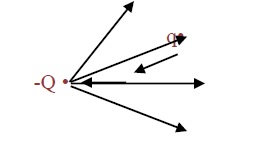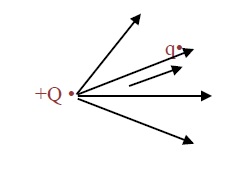Electric Field Intensity Measurement
Description:
We know that,
E→ = F→q .........(1)
Here, electric field intensity (E) is a vector quantity and its direction is same as that of force experienced by the test charge.
F→ = qE→ ........(2)
When a source charge (Q) applies force on a test charge(q), then the force experienced by the test charge is given by −
F→PQ = 14πε0qQr2r̂qQ .......(3)
from 1 and 3;
qE→ = 14πε0qQr2r̂qQ
E→ = 14πε0qQr2qr̂qQ
E→ = 14πε0Qr2r̂qQ
Note −
Electric field intensity (E) when test charge is given: E→ = F→q
Electric field intensity (E) when source charge is given: E→ = 14πε0Qr2r̂qQ
Unit of E −
Since E→ = F→q
Therefore, unit is: E = NC-1
Dimension of E −
|E| = MLT-2AT
|E|→ = MLT-3A-1
Note −
1. Electric field intensity (E) is having a sign also.
- If the source charge (Q) is negative (-) then electric field intensity (E) will also be (-).
- If the source charge (Q) is positive (+) then the electric field intensity (E) will also be (+).
2. The test charge (q) is always considered as positive (+)
3. If force on ‘q’ is directed towards the source charge (Q) (i.e q is experiencing force of attraction) it means Q is (-ve).

4. If ‘q’ is directed away from the source charge (Q) (i.e q is experiencing force of repulsion) it means Q is (+ve ).


